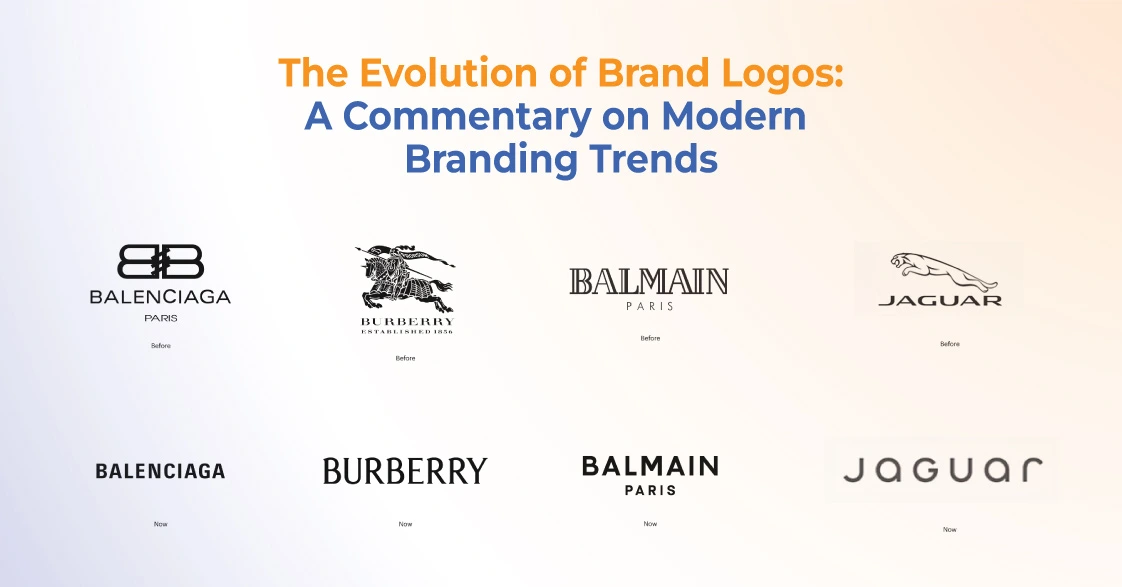The Evolution of Brand Logos: A Commentary on Modern Branding Trends

Take a good look at these logo transformations. They tell a story far more profound than just design updates. We're in the middle of a branding revolution sweeping across industries. It's not just about minimalism or "mobile-first" thinking. We're witnessing the excellent homogenization of global brands.
Minimalism or Monotony? The Shift Toward Sameness
Look at the logo updates for brands like Saint Laurent, Balenciaga, and Burberry. Once defined by elegant flourishes and distinct typography, these brands have transitioned into bold, minimalist sans-serif fonts. The rationale? Clarity, simplicity, and adaptability across digital platforms.
But here's the hidden cost: the distinction is dying. The elements that once made these brands iconic are stripped away in favour of a uniform aesthetic. To remain modern and universally appealing, they're creating a "vanilla" branding landscape where risk-taking and individuality are liabilities.
The Two Lanes of Modern Branding
As global brands race to stay relevant, two clear strategies are emerging:
-
Homogenization for Mass Appeal:
Big luxury names are normalizing their visual identity to appeal to global audiences. The risk? Losing the uniqueness that made them aspirational in the first place.
-
Radical Differentiation for Survival:
Struggling brands adopt extreme, often polarising designs to stand out in saturated markets. However, this approach can confuse loyal customers and undermine long-standing brand equity.
Neither of these paths feels like an actual strategy. They seem
more desperate with a design budget.
What This
Means for Modern Branding
Brands today face an identity crisis. Many are sacrificing the elements that made them iconic to adapt to changing times. Distinction is now seen as risky, while homogenization is rewarded for its "safety."
But here's the reality:
- Homogenized branding may please algorithms, but it erodes emotional connection.
- Radical reinvention can generate buzz but risks alienating the loyalists who drive revenue.
Let's talk more about Logos.
Jaguar Logo Evolution:
Introduction: The Transformation of Jaguar's Identity
- Jaguar, a name synonymous with luxury, sophistication, and performance, has
recently revamped its iconic logo. This redesign reflects a bold shift in
branding strategy to appeal to modern sensibilities. Let's break down the old
and new designs, analyze their significance, and explore the implications for
Jaguar's brand identity and audience engagement.
The Old Jaguar Logo: A Symbol of Elegance and Tradition
The classic Jaguar logo was a visual representation of the brand's core values:
- Leaping Jaguar Icon: The leaping jaguar symbolized agility, power, and dynamism, embodying the essence of Jaguar vehicles.
- Serif Text: The serif typeface exuded class and sophistication, resonating with the brand's luxurious and traditional identity.
- Timeless Appeal: Together, the icon and serif text established a strong connection to Jaguar's heritage, appealing to a loyal customer base that values classic luxury.
This design was instantly recognizable, becoming a key element in defining Jaguar's
legacy in the automobile industry.
The New Jaguar Logo: Minimalism Meets
Modernity
Jaguar's new logo introduces a simplified and modernized aesthetic:
- Sans-Serif Font: The new design features a sleek, minimalist sans-serif typeface, embodying a contemporary and digital-first approach.
- No Icon: The leaping jaguar icon has been removed, prioritizing simplicity over the dynamic imagery of the past.
- Versatility: The minimalist design is ideal for digital platforms and responsive branding across modern mediums.
The shift reflects a deliberate effort to reposition Jaguar as a forward-thinking
brand that aligns with the preferences of younger, tech-savvy
consumers.
Analysis: Navigating the Pros and Cons of the Redesign
While the new logo signifies progress, it also introduces challenges that could impact Jaguar's brand perception.
Advantages of the New Logo:
- Modern Appeal: The sleek design resonates with younger demographics who value minimalism and innovation.
- Digital Adaptability: The simplified font is optimized for digital platforms, ensuring clarity and consistency across screens.
- Brand Refresh: The redesign signals a move towards embracing contemporary trends and staying competitive in the evolving automobile market.
Challenges of the New Logo:
- Loss of Iconic Symbolism: Removing the leaping jaguar sacrifices a visual element that defines Jaguar's heritage and brand personality.
- Risk of Alienation: Traditional customers who associate Jaguar with classic luxury and timeless elegance may feel disconnected from the new branding.
- Identity Shift: Striking a balance between modernity and
heritage is critical to avoid losing the essence of the Jaguar brand.
Yves Saint Laurent → Saint Laurent: A Logo Transformation
- Old Logo:
The original Yves Saint Laurent logo featured an intricately designed intertwined serif style, reflecting timeless luxury, elegance, and the artistic vision of its founder, Yves Saint Laurent. This iconic design symbolized the height of sophistication in the fashion world.
- New Logo:
The revamped logo simplifies the brand to "Saint Laurent", using bold, clean sans-serif text. This minimalist design aligns with modern branding trends, catering to a younger, contemporary audience while maintaining a sense of refinement.
- Analysis:
The change signifies a shift toward modernity and accessibility, appealing to the digital age's aesthetics and a broader consumer base. However, by removing "Yves" and the intricate serif design, the logo sacrifices some of its founder's original flair, artistic identity, and personal legacy. This decision reflects the brand's focus on evolving with current trends while taking a calculated risk of losing its historic charm.
Balenciaga: A Logo Evolution
- Old Logo:
The previous Balenciaga logo showcased a classic serif typeface, emphasizing the brand's rich legacy in haute couture. This design reflected Balenciaga's traditional roots, elegance, and status as a fashion industry pioneer.
- New Logo:
The updated logo adopts bold, minimalist sans-serif typography, highlighting clarity, simplicity, and modernity. The clean lines and uniform structure make it ideal for digital platforms and resonate with contemporary design trends.
- Analysis:
The new logo positions Balenciaga as a forward-thinking brand, catering to a younger, tech-savvy audience. Its minimalist style ensures visibility and adaptability across digital spaces, from social media to mobile interfaces. However, this change aligns with the trend of uniformity in luxury branding, where many high-fashion brands adopt similar sans-serif designs. While it enhances practicality, it risks losing some of the distinctiveness and heritage charm that once set Balenciaga apart.
Burberry: A Logo Redesign Rooted in Modernity
- Old Logo:
Burberry's original logo featured an elegant serif typeface paired with "London, England" in smaller text. This design celebrated the brand's British heritage and its legacy in crafting timeless, sophisticated fashion. The serif font evoked a sense of tradition and refinement that resonated with Burberry's long-standing identity.
- New Logo:
The updated logo adopts a bold, uppercase sans-serif font, bringing a sleek and minimalist touch to the design. It retains the "London England" tagline beneath the main text, preserving a nod to its origins while aligning with modern aesthetics.
- Analysis:
The new logo reflects modernity and digital adaptability,
ensuring it stands out in social media, mobile interfaces, and other online
platforms. However, this shift comes at a cost: the timeless
sophistication of the old serif design is lost, potentially diluting
the emotional connection to the brand's heritage. While the new look appeals to a
younger, tech-savvy audience, long-time admirers of Burberry's classic charm may
feel the redesign lacks depth and tradition.
Berluti: A Logo Redesign Balancing
Tradition and Modernity
- Old Logo:
Berluti's previous logo featured a serif font with subtle flourishes, embodying the brand's Parisian elegance and long-standing tradition in luxury craftsmanship. This design resonated with Berluti's traditional clientele, emphasizing its roots in refined artistry and sophistication.
- New Logo:
The updated logo adopts a bold sans-serif typeface, reflecting a more modern, minimalist approach. It retains the "Paris" subtitle, connecting to its geographic and cultural heritage while positioning itself for a contemporary audience.
- Analysis:
The redesign showcases Berluti's intent to embrace modern branding
trends, appeal to a younger, global demographic and ensure the logo's
adaptability across digital and physical mediums. However, this shift sacrifices
the classical aesthetic that defined Berluti's identity and
differentiated it in the luxury space. For long-time customers who valued the
elegance of the old design, the new logo might feel less personal and connected to
the brand's artisanal heritage.
Balmain: A Logo Redesign Reflecting Modern
Minimalism
- Old Logo:
Balmain's previous logo featured a stylized serif font, showcasing the brand's high-fashion heritage and French elegance. This design reflected Balmain's reputation for sophistication and deep roots in Parisian haute couture, resonating strongly with its traditional clientele.
- New Logo:
The updated logo shifts to a bold sans-serif typeface, paired with "Paris" underneath. This clean, minimalist design reflects modern branding trends, focusing on simplicity and a streamlined aesthetic that appeals to a global, contemporary audience.
- Analysis:
The redesign follows the increasing trend among luxury brands to
embrace minimalist branding for better adaptability in digital
spaces. The bold, clean lines ensure clarity and visibility across online platforms,
from social media to e-commerce. However, this move comes at the cost of losing
the distinctive flair and artistic character
of the previous serif font, which symbolized Balmain's luxurious and
storied identity.
The Trend of Homogenization
Luxury brands increasingly shift from intricate serif typography to bold, minimalist sans-serif fonts. This change emphasizes simplicity and digital adaptability, making logos more universal and modern. However, it sacrifices individuality and heritage, leading to a homogenized visual landscape where brands lose some of their unique identity and connection to tradition.

FAQs
Share
Table Of Contents
- Minimalism or Monotony?
- he Two Lanes of Branding
- Balenciaga: A Logo Evolution
- Burberry: A Logo Redesign Rooted in Modernity
